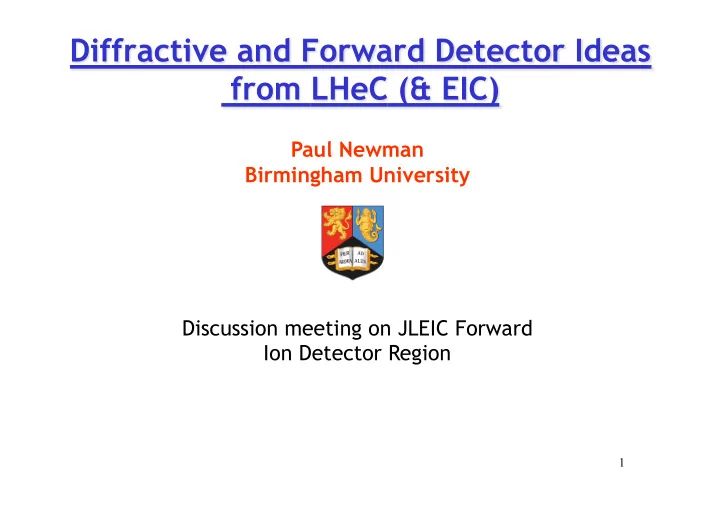

Paul Newman Birmingham University Discussion meeting on JLEIC Forward Ion Detector Region 1
e p • Forward / backward asymmetry reflecting beam energies • 1 o electron hits two tracker planes 2 • Present size 14m x 9m (c.f. CMS 21m x 15m, ATLAS 45m x 25m)
Vital to go as far forward as possible Need 1 o acceptance in outgoing proton direction to contain multi-TeV jets at high x (essential for kinematic reconstruction; electron-only method breaks down) High W / Low x
1) Measure scattered Proton in Roman Pots - Allows t measurement, but limited by stats, p- tagging systs η max 2) Select Large Rapidity Gaps - Limited by control over proton dissociation contribution • Methods have very different systematics à complementary • In practice, method 2 yielded lasting results, because of statistical and kinematic range limitations of Roman pots • Roman pots mainly contrained t distributions • Different at EIC? à higher lumi + pot design from outset
- η max v ξ correlation entirely determined by proton beam energy - Cut around η max ~ 3 selects events with x IP <~ 10 -3 at LHeC (cf x IP <~ 10 -2 at HERA
- Proton spectrometer uses outcomes of FP420 project (proposal for low ξ Roman pots at ATLAS / CMS – not yet adopted) - - Approaching beam to 12 σ (~250 µ m) tags elastically scattered protons with high acceptance over a wide x IP , t range Complementary acceptance to Large Rapidity Gap method Together cover full range of interest with some redundancy
Experimentally clear signatures and theoretically cleanly calculable saturation effects in coherent diffraction case (eA à eVA) Experimental separation of incoherent diffraction based mainly on ZDC à 7
- Assumed to be crucial in eA to distinguish coherent from incoherent diffraction - Also in ed, to distinguish scattering from p or n - Forward γ and n cross sections relevant to cosmic ray physics - Has previously been used in ep to study π structure function Possible space at z ~ 100m (also possibly for proton calorimeter) ?… can we add charged particle tagging close to zero degrees?
Proton dissociation Contamination: - From ratio of measurements with gaps and Roman pots, 2006 H1 rapidity gap measurement had 10% normalisation uncertainty due to `invisible’ proton dissociation with M Y < 1.6 GeV - Largest single uncertainty on H1 Fit B Diffractive PDFs
- Given η min (Y) ~ ln M Y , observing proton dissociation fragments as close to the beam as possible improves rejection and hence quality of Rapidity Gap measurement. - Previous methods at HERA and LHC have used scintilating tiles around beampipe, which misses the lowest M Y states à What if we used Roman pots to detect Proton dissociation fragments inside beampipe and hence have acceptance for all M Y ? à Similar approach for nuclear fragment detection in eA? … starts to be done e.g. with ATLAS AFP 11
Intact beam particle tagging and measurements using machine elements for dispersion usually require Roman pot Approach to beam from single side Remnant tagging inside beampipe would require full azimuthal acceptance for Sensitive detectors housed in pots à Possible design with eg overlapping semi-circles of pixel arrays? à Scope for an R&D programme, also investigting eg edgeless sensors? 12
Recommend
More recommend